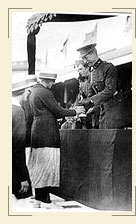|
 Did you know?
Did you know?
- The Soviet Union abstained from all Olympic organizations
between 1920 (Antwerp) and 1952 (Helsinki). Thence it had
participated in all the organizations,  with
the exception of the 1984 Los Angeles Games. That abstention
was the "reply" of the Soviet Union to the USA who had boycotted
the 1980 Moscow Games. with
the exception of the 1984 Los Angeles Games. That abstention
was the "reply" of the Soviet Union to the USA who had boycotted
the 1980 Moscow Games.
- The medals that were awarded to the first Olympic winners in the Games of 1920 were not made of gold. Due to the economic recession the medals were silver plated.
- The world record set by Ethelda Bleibtrey at the Games of 1920 in the 300m freestyle remained unbroken. Indeed, the following year that event was removed and replaced by the 400m freestyle, the same distance with the men's corresponding event. As a result, Bleibtrey's record was never broken.
- The first Olympic flag was lost right after the closure of the Antwerp Games. The perpetrator was the Armenian-American athlete Hal Haig Prieste, who came third in diving. Prieste kept the flag for decades and returned it to the then president of the IOC, Juan Antonio Samaranch, during a special ceremony held as part of the 2000 Sydney Olympics. 80 years had elapsed from the previous appearance of the flag in the Olympic Games and of the superannuated (104 years old) Prieste.
- It was probably inexperience that deprived Paavo Nurmi of one more gold medal. The first race of Nurmi in the Games of Antwerp was the 5,000m, where he ranked second. Nurmi had the lead over the largest part of the race, however in the end he was taken by surprise, when he was "attacked" by the French Joseph Guillemot, the winner of the event. Three days later, Nurmi beat Guillemot in the 10,000m, after having readjusted his tactics following the advice of Kolehmainen.
|